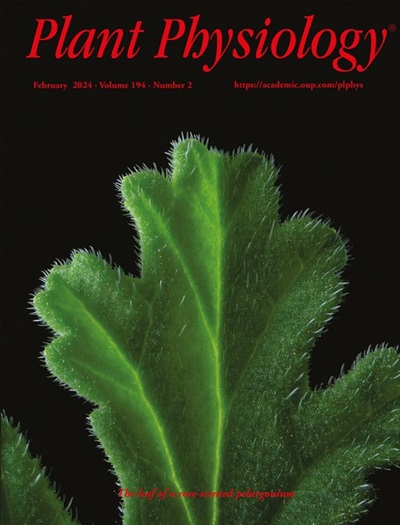MYB30-INTERACTING E3 LIGASE 1 regulates LONELY GUY 5-mediated cytokinin metabolism to promote drought tolerance in cotton
IF 6.5
1区 生物学
Q1 PLANT SCIENCES
引用次数: 0
Abstract
Ubiquitination plays important roles in modulating the abiotic stress tolerance of plants. Drought seriously restricts agricultural production, but how ubiquitination participates in regulating drought tolerance remains largely unknown. Here, we identified a drought-inducible gene, MYB30-INTERACTING E3 LIGASE 1 (GhMIEL1), which encodes a RING E3 ubiquitin ligase in cotton (Gossypium hirsutum). GhMIEL1 was strongly induced by polyethylene glycol (PEG-6000) and the phytohormone abscisic acid (ABA). Overexpression and knockdown of GhMIEL1 in cotton substantially enhanced and reduced drought tolerance, respectively. GhMIEL1 interacted with the MYB transcription factor GhMYB66 and could ubiquitinate and degrade it in vitro. GhMYB66 directly bound to the LONELY GUY 5 (GhLOG5) promoter, a gene encoding cytokinin riboside 5'-monophosphate phosphoribohydrolase, to repress its transcription. Overexpression of GhMIEL1 and silencing of GhMYB66 altered the homeostasis of cytokinin of plant roots, increased total root length and number of root tips, and enhanced plant drought tolerance. Conversely, silencing GhLOG5 decreased total root length and number of root tips and reduced plant drought tolerance. Our studies reveal that the GhMIEL1-GhMYB66-GhLOG5 module positively regulates drought tolerance in cotton, which deepens our understanding of plant ubiquitination-mediated drought tolerance and provides insights for improving drought tolerance.MYB30-INTERACTING E3 LIGASE 1 调节 LONELY GUY 5 介导的细胞分裂素代谢,促进棉花的抗旱性
泛素化在调节植物的非生物胁迫耐受性方面发挥着重要作用。干旱严重制约了农业生产,但泛素化如何参与调控抗旱性仍是一个未知数。在这里,我们在棉花(Gossypium hirsutum)中发现了一个干旱诱导基因--MYB30-INTERACTING E3 LIGASE 1(GhMIEL1),它编码一种RING E3泛素连接酶。聚乙二醇(PEG-6000)和植物激素脱落酸(ABA)能强烈诱导 GhMIEL1。在棉花中过表达和敲除 GhMIEL1 分别大大提高和降低了耐旱性。GhMIEL1 与 MYB 转录因子 GhMYB66 相互作用,并能在体外泛素化和降解它。GhMYB66 直接与编码细胞分裂素核苷-5'-单磷酸磷酸核苷水解酶的基因 LONELY GUY 5(GhLOG5)启动子结合,抑制其转录。过表达 GhMIEL1 和沉默 GhMYB66 改变了植物根部细胞分裂素的平衡,增加了根的总长度和根尖数量,并增强了植物的耐旱性。相反,沉默 GhLOG5 会减少根的总长度和根尖数量,降低植物的耐旱性。我们的研究揭示了 GhMIEL1-GhMYB66-GhLOG5 模块正向调控棉花的耐旱性,加深了我们对泛素化介导的植物耐旱性的理解,为提高耐旱性提供了启示。
本文章由计算机程序翻译,如有差异,请以英文原文为准。
求助全文
约1分钟内获得全文
求助全文
来源期刊

Plant Physiology
生物-植物科学
CiteScore
12.20
自引率
5.40%
发文量
535
审稿时长
2.3 months
期刊介绍:
Plant Physiology® is a distinguished and highly respected journal with a rich history dating back to its establishment in 1926. It stands as a leading international publication in the field of plant biology, covering a comprehensive range of topics from the molecular and structural aspects of plant life to systems biology and ecophysiology. Recognized as the most highly cited journal in plant sciences, Plant Physiology® is a testament to its commitment to excellence and the dissemination of groundbreaking research.
As the official publication of the American Society of Plant Biologists, Plant Physiology® upholds rigorous peer-review standards, ensuring that the scientific community receives the highest quality research. The journal releases 12 issues annually, providing a steady stream of new findings and insights to its readership.
 求助内容:
求助内容: 应助结果提醒方式:
应助结果提醒方式:


